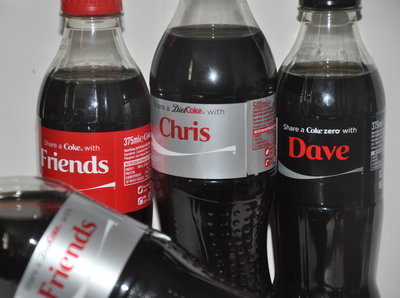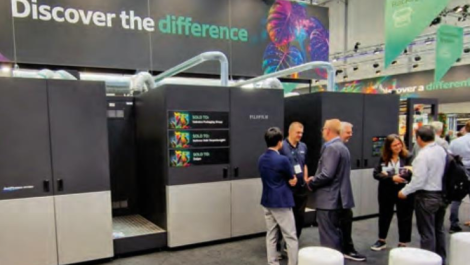If you go down to a shop today you may well be in for a surprise. There may be a bottle of Coke with your name printed on it. Across 32 European countries, there are 800 million personalised bottles on the shelves as Coca-Cola uses digitally printed labels to boost the iconic brand. By Sean Smyth.
It is not just the lower cost of short runs that is driving the adoption of digital labels. Competition is making brands take new views on how to connect with customers and some companies are investing in digitally printed packaging as the technology becomes more productive and reliable.
In the summer of 2011-12, Coca-Cola ran a campaign to re-connect with customers in Australia. It produced personalised bottles, choosing 150 of the most popular names in the country and printing them onto bottles and cans with the message ‘Share a Coke with . . .’. It used the Agfa Dotrix inkjet presses at LeMac to overprint analogue labels, with some of the lower runs on HP Indigo label presses. A further 50 names were added to the list and there were also 378,000 cans produced on demand.
The results were impressive. In the three month campaign, there was an overall 4% increase in sales. Young adults were the main target and their consumption was up by 7%. The campaign engaged customers, reaching 13.9 million people and local traffic on Facebook increased by 870% with 121 million earned impressions and fan growth of 39%.
European campaign
This summer the campaign is running across Europe, with all the personalisation produced on HP Indigo WS6600 presses, probably the biggest ever personalised brand campaign producing 800 million high quality personalised labels. Each label is 205×37.5 mm in size, printed on a 38 micron BOPP wraparound. The campaign is running in 32 countries, substituting the Coca-Cola logo with 150 popular first names, nicknames and terms of affection in each country.
The project was managed by Dutch label converter Eshuis, based in Dalfsen, which co-ordinated eight digital label converters across Europe. Twelve WS6000 presses were used, running for 24 hours per day over three months.
‘During the months of continuous printing, the Indigo presses have proven to be exceptionally reliable, achieving record productivity and press uptime of 86%,’ said Peter Overbeek, managing director of Eshuis. ‘With such a strong European network of PSPs using HP Indigo digital presses, the opportunities for brand owners like Coca-Cola are endless.’
Colours and calibration
The static content on the labels for this project was first printed using flexo and gravure, and then personalised. It was necessary to mix the names up throughout the run, so that the final bottles delivered to a particular outlet had a distribution of names. There were also varying quantities according to the popularity of the chosen names and this fitted well with the capability of the digital technology. To minimise costs, part of the label was printed with the standard gravure and flexo inks, leaving a gap where the name was then digitally overprinted with Coke red as a spot colour (and black for Coke Zero).
All the HP Indigo presses used were calibrated and set to the same configuration and settings for complete alignment and consistency during production. One of the competitive advantages that Indigo technology offers is the ability to print spot colours. Presses have up to seven colour stations for an extended process colour set to widen the colour gamut, or to use separate white and spot colours. This was the case for this project, and it provided the benefit of a single click with a lower cost and faster speed. The digital Coke red ink was used as the standard for all of the conventional and digital printing and will serve as the reference colour for Coca-Cola in future.
Dorchester-based Amberley Labels was one of the eight converters involved, and managing director, Trevor Smith, was pleased with the colour consistency from the company’s WS6600 presses. The target was for a maximum colour variation in ΔE ≤ 2 across all labels. This was straightforward for the digital printing that varied to a maximum ΔE of 0.5-0.7 from the standard, and Mr Smith said it was, ‘Easy to hold at this level. Our brief was not to try and ‘chase’ the flexo or gravure red, but to stick to the Coca-Cola red standard. However, as the gravure and flexo often ran outside of 2 (we had to a get concession to run up to ΔE = 2.5), it did sometimes mean that the digitally printed panel stood out more than we would have ideally liked it too.’ Colour consistency is another example of the benefit of digital production as the colour variation between gravure and flexo printers was significantly higher than for the digital side.
Alon Bar-Shany, VP and general manager of the HP Indigo Division was very excited by the results at the recent Dscoop meeting in Beijing, ‘There are tremendous opportunities for companies to better engage with their customers by making their brand and product stand out on store shelves through customised packaging. The HP Indigo presses proved their long-run production capabilities by meeting the needs of a project of this scale on time and aligned with Coca-Cola brand standards.’
Touch points
As digital label printing matures, it is being used for more than just an economic method of short run production, as 800 million Coke labels will attest. All brands are increasingly keen to appeal to their customers. Marketers talk about the touch points (any point of interaction between the brand and a consumer) and how they can differentiate themselves from the competition. There are many competing messages and one of the key benefits of social media is that a message often will get to the end user via a friend or trusted source. Being a friend on Facebook or a follower on Twitter is a positive action on behalf of the consumer that will tell a brand it is gaining approval. Running campaigns on these platforms is one way to gain approval of the target customer groups. Along with the personalised bottles, the portal www.shareacocacola.com provides a platform for consumers to experience the campaign virtually with friends and family across the world. The site can be used to create and personalise virtual cans to send to Facebook friends.
For a brand like Coke, the benefits of personalisation are being exploited. There may be sales boosts in certain markets, but overall it is engaging with consumers and building brand loyalty that is important. Using digital labels is proving to be a successful method of driving traffic and creating a buzz. This is good for printers, because helping the marketing department to execute a new campaign means that the unit price of a label is not necessarily a significant part of the purchasing agreement. Many brands are seeking new ways to connect and cement their relationship with their consumers and potential customers and digital print can help. The volumes of product involved can be significant as the ‘Share a Coke’ campaign demonstrates.
DL&P spoke to Nilton Mattos, the principal engineer for global packaging R&D for the Coca-Cola Company at the head office in Atlanta. The ‘Share a Coke with . . .’ project was some six years in gestation, with the concept determined by the team lead by Mr Mattos. Coca-Cola keeps a close eye on the developing packaging technology, investing in digital print in-house, and as the productivity and quality of digital presses has improved, more possibilities are opened.
When the Agfa Dotrix presses were installed at Australian flexible packaging manufacturer LeMac in 2010, the local marketing department of Coca-Cola refined the concept of personalised bottles together with the converter and Agfa. Significant investment to deliver the project was needed, it is the marketing function that drove the original project and they needed to convince the other stakeholders in the supply chain, notably the local bottlers.






